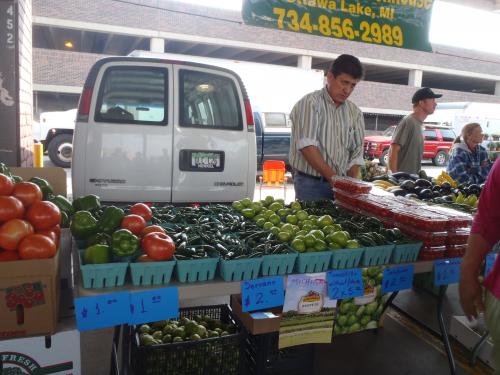Michigan State University Product Center assists Farmers on the Move Cooperative, Inc.
Southwest Michigan Hispanic Grower Cooperation improving profitability through farmer educational knowledge

Farmers on the Move (FOTM) are a cooperative of Hispanic farmers incorporated in June of 2009 to create a quality retail brand of fresh blueberries and vegetables for the Michigan and Midwest markets. The objectives are to provide a reliable supply of quality products year after year. Guiding this effort, Filiberto Villa Gomez, board president has consistently striven to enhance member knowledge in both growing and selling activities. With the help of Michigan State University Extension and the MSU Product Center this goal is possible. The members work collectively to produce and package blueberries and vegetables. Together they process, package, deliver and share marketing expenses. Working together enables them to supply their product more efficiently and competitively, so as to realize greater profitability. Sales began in 2011.
Additionally, the cooperative helps to expand the dwindling network of family-owned farmers that contribute to a healthy and economically viable local farming community making up an important part of Michigan’s agricultural industry. FOTM provides sustainable business growth by continuing to build a framework that fuels farmer’s entrepreneurial spirit. Additionally, the cooperative has provided and coordinated trainings and educational resources to the Southwest Michigan Hispanic agricultural community. Some of the areas covered include; cultural techniques, pesticide application license class room work, generally accepted agricultural practices, and cooperative procedural activities.
The number of Hispanic farms in Michigan continues to grow. They represent a committed group of farmers that help preserve the local farming community. The need to be competitive is overcome by working together to provide a reliable and competitive source of quality locally grown berries and vegetables that can compete in the grocery retail and wholesale area, as well as at farmers markets. Moreover, while the cooperative continues to gain brand acceptance and build sales, a membership development marketing and communication plan along with personal outreach has been utilized to attract new members.
A packing house was established in 2012. Sorting machinery was secured by additional member investments and processing duties were shared. Marketing of products together both secured higher prices and built the brand. The cooperative was a recipient of a USDA Small Socially Disadvantaged Technical Assistance Grant in 2009 to develop marketing resources; brand, and marketing materials for both external and potentially internal audiences.
The cooperative members identified the common need for reliable spraying equipment and a tractor that could be moved among the farms for uniform pesticide application to ensure traceability and accountability. The cooperative purchased a tractor and sprayer in 2013 for this purpose. Financing was a combination of new member investment in preferred stock and seller financing. While logistics and differing grower expectations brought forth some tension, a common understanding was put in place that will in the long run prove to be an important template for future equipment sharing opportunities. The cooperative is working with other regional cooperatives in both obtaining inputs and marketing. Lines of credit for members have been granted and group cohesiveness has protected this trust.
FOTM currently has 14 members with farms from 5 to 50 acres. Expansion of the member base with additional market knowledge should allow for sales numbers to grow. New marketing opportunities include ready to serve portion packing of blueberries and hoop houses to extend the seasonal offerings.
Visit the cooperative website is and their Facebook page for more information. FOTM has worked closely with the Michigan State University Product Center during its formation and growth and has utilized resources through the USDA Rural Cooperative Development Program.



 Print
Print Email
Email




